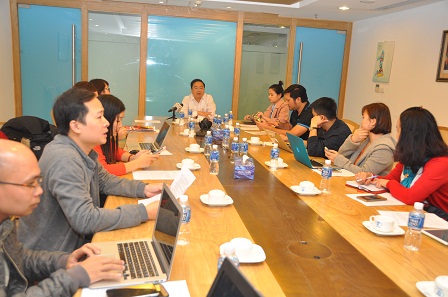


Vinatex announces business results in 2017 and 2018 tasks
04-01-2018
On the first day of New Year's Day, the Vietnam Textile and Garment Group (Vinatex) held a press conference announcing the production and business results in 2017 and the orientation for 2018.

In addition to maintaining good growth in major export markets such as the US, EU, Japan and South Korea, the Vietnamese textile and garment industry has been striving to diversify its markets and make a breakthrough. Vietnam has 6 export markets with over 1 billion USD, including the US, the EU, ASEAN, Japan, Korea and the Middle East. National. According to Le Tien Truong, if the problem of banking in Russia is resolved (currently companies in Russia can not pay directly but through a bank of a third country) and penetrate deeper into Australia through the CPTPP agreement, Russia and Australia will be the two next $ 1 billion export market of Vietnam.
Apart from traditional textiles, high value added products such as fabric, fiber, geotextile, textile and garment accessories have also grown very well. The position of Vietnam's textile industry is relatively good among the major textile exporters in the world. Big customers are high priority and see Vietnam as the center of supply when ordering. Having achieved such success, according to Le Tien Truong, the whole industry has focused on improving production management capacity, product quality, commitment to timely delivery and investment in upgrading machinery and equipment. Modern automation to reduce costs per unit of product.
Efforts to change technology
According to Le Tien Truong, the world is in the hinge of the 4.0 technology revolution, posing many challenges in terms of competitiveness and development for Vietnam. At present, foreign textile enterprises are investing in modern factories, so if Vietnamese enterprises do not move, they will lose their opportunities and no longer be able to compete by 2020. The lower unit price, especially for standard orders such as shirts and trousers, the average price dropped from 10% to 15% in 2017 and will continue to decrease, while Costs in Vietnam have increased, including electricity prices, wages, transportation, ... and less and less depreciation of machinery. Therefore, the only way to compete with textile exporters in general and with FDI enterprises in particular is to reduce labor costs per unit of product, ie per capita productivity, price production per capita must increase. Mr. Le Tien Truong, if any equipment can replace manual labor, will have to invest. Although the investment will be more, immediately see higher wages and in the investment phase can reduce the rate of return, affecting business performance. However, the depreciation is at the enterprise and this amount is the potential for business to continue to use to reinvest, expand production in the direction of more modern. In addition, with the advent of technology, new garment enterprises can increase productivity, shorten delivery times, increase employee salaries, attract staff and simultaneously Solving the problem of labor competition with other occupations in society.
It is estimated that with annual growth rate of 10%, DMVN needs 200,000 new employees every year. However, when the sector can focus on investing in high-tech equipment, it can still grow at 10%, but only need to recruit 100,000 workers a year. Moreover, when the industry applies the management technology that connects all stages of the production process, it also reduces inventory costs. For example, the May can know what information weaving products, which may be appropriate, registered immediately so that after weaving, the goods will be transferred right to the sewing, saving time for the storage of Textile and Reduced delivery time for the May party. This information link enables the parties to use each other's products in the fastest production chain, optimizing transit times, and reducing overall costs throughout the production process.
Target to reach USD 34 billion export turnover in 2018
2018 is forecasted to be a sustainable global GDP, but political and economic instability in the world, especially the situation in Korea and the United States, may have a negative impact on consumer demand. Consequently, the global textile and garment demand will only increase by 1-2%, even without change. However, the Vietnam Textile and Garment Industry has set a high target, striving to achieve a growth of $ 34 billion, a 10% increase compared to 2017. To achieve such growth figures, according to Le Tien Truong, The industry must devote itself to changing technologies, taking the lead in investing and mastering the products on the world market in order to create a stable, sustainable and efficient textile and garment industry.
Source vinatex.com